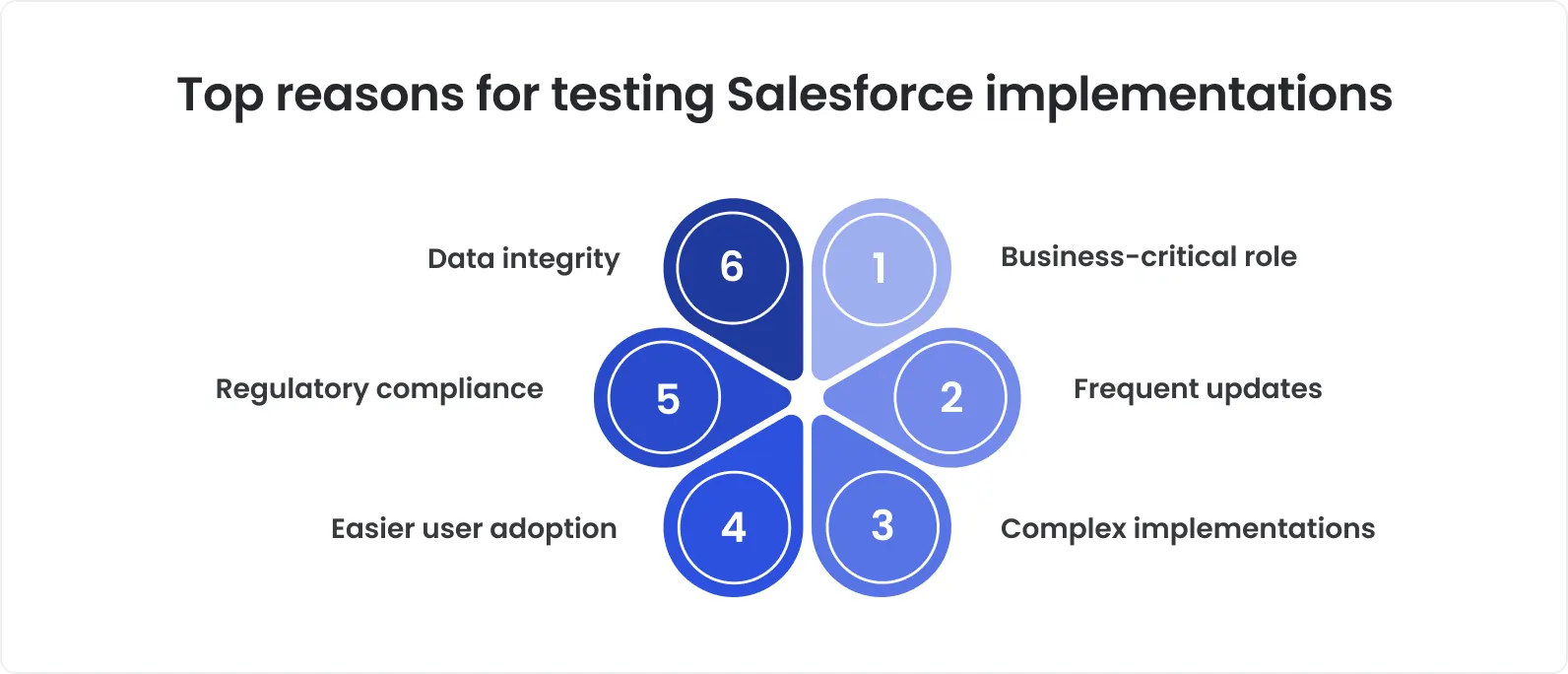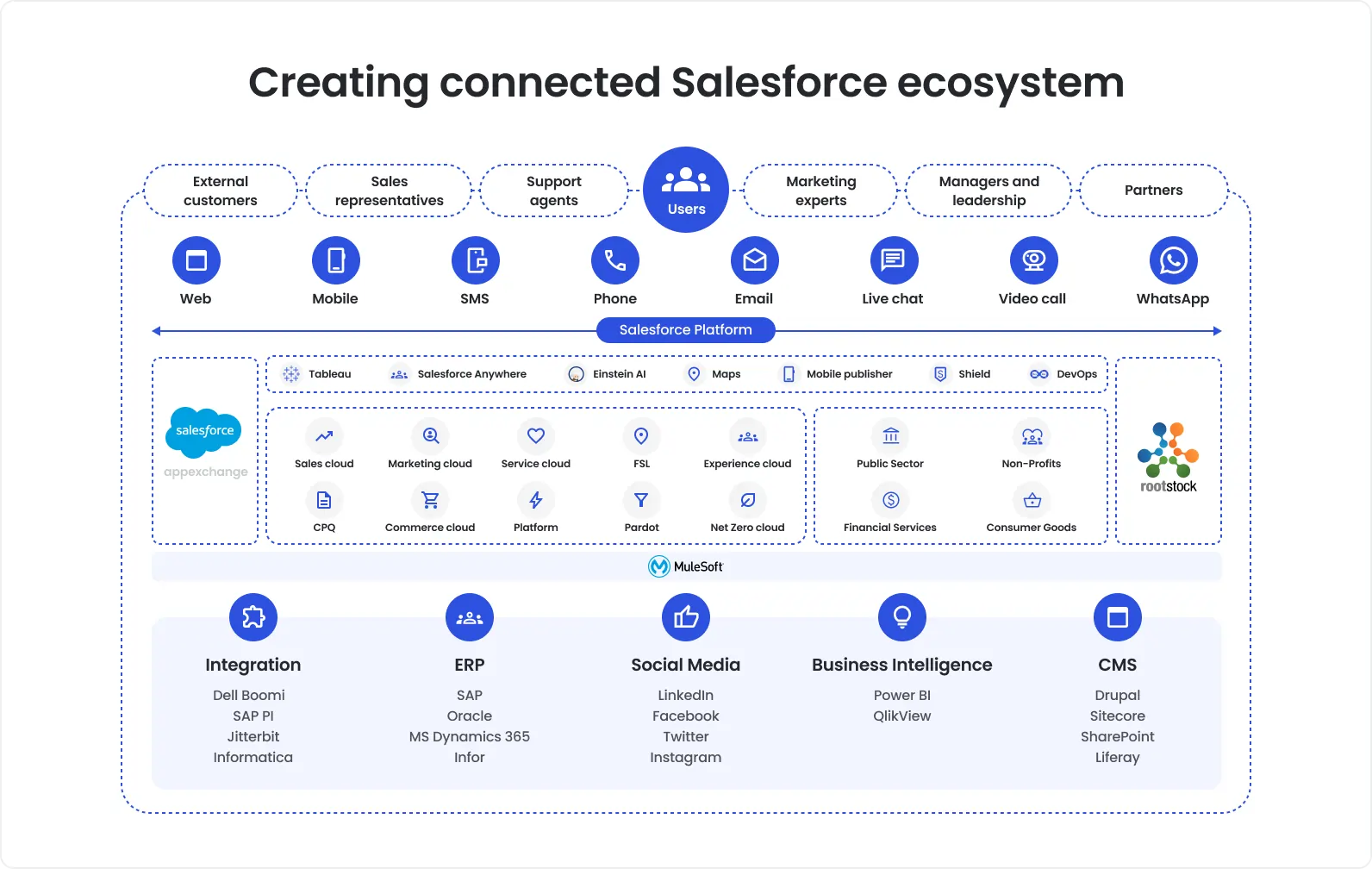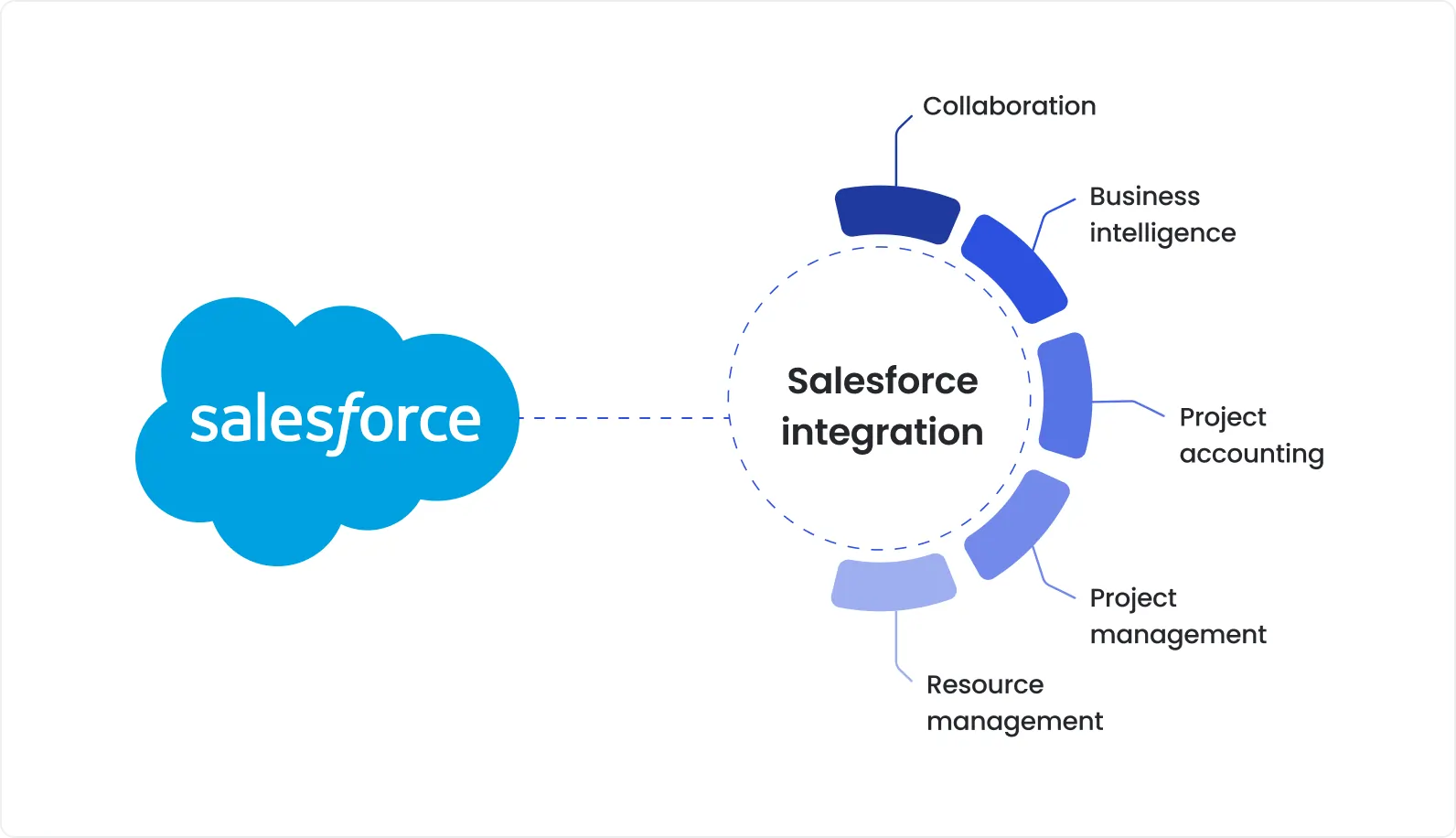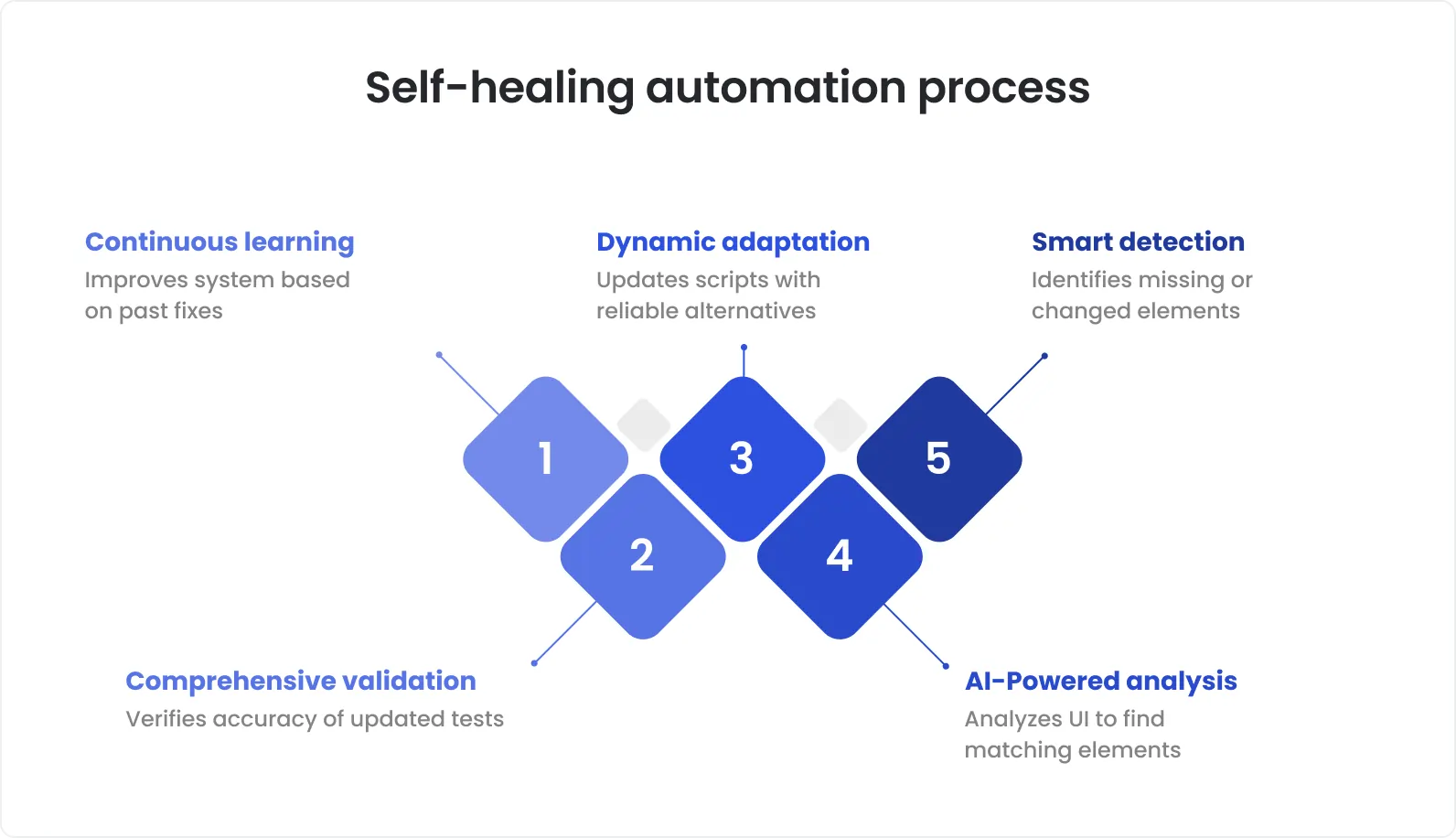What is the most popular CRM solution in the world? Undoubtedly, it’s Salesforce. With a global market share of 20.7%, it was ranked the #1 CRM provider for the 12th consecutive year in 2025.
Salesforce is used across diverse industries like financial services, healthcare, public sector, education, manufacturing, and retail, helping companies to tackle the most critical business operations.
Yet, while the platform itself is powerful, as many as 70% of Salesforce implementations fail to meet business objectives. Inadequate planning, poor change management, and over-customization are among the common reasons, but the real issue is often a lack of proper testing.
With extensive customizations, complex configurations, multiple integrations, and custom code, Salesforce solutions require comprehensive testing. Without it, businesses risk facing disrupted operations, security issues, compliance violations, and user adoption problems. As a result, in 2025, Salesforce testing remains as important as ever, helping companies have efficient workflows in place.
Have gaps in your Salesforce QA testing? No worries – we are here to explain to you key nuances, common challenges, leading tools, best practices, and everything you need to ensure a top-quality Salesforce experience.
Salesforce testing and its importance in 2025
Salesforce testing is performed to check if a Salesforce implementation works as expected. It ensures the stability, functionality, security, and performance of your solution, as well as its adherence to specific business needs.
A special software testing and QA approach is required for Salesforce solutions as the platform has a unique nature, primarily due to configurability and reliance on declarative (point-and-click) setup, numerous integrations, and customizations implemented via custom code written in Apex or Lightning Web Components (LWC).
Core aspects of Salesforce testing
While Salesforce testing is holistic and covers a lot of aspects, for the beginning, we’d like to highlight key ones that deserve your particular attention:
- Configurations
Salesforce is known for its high level of configurability and reliance on declarative (point-and-click) setup. Misconfigured components lead to missing data, poor user experience, or even improper work of critical processes. To ensure high quality, it’s crucial to verify that both standard and custom settings like objects, fields, page layouts, profiles, user roles, and permissions are correctly defined and work as needed.
- Integrations
75% of Salesforce users integrate the platform with various external apps. Such integrations, when broken, affect data quality, cause compliance issues, and impact key workflows. Testers must always validate data submitted to Salesforce from external systems for accuracy, formatting, and timeliness. Also, API calls must be carefully checked for authentication, response structure, data mapping, and error handling.
- Custom code
To handle sophisticated scenarios, most Salesforce implementations include custom code written in Apex or structured as Lightning Web Components (LWC). This code is usually the source of regression bugs or performance issues and must be carefully tested to ensure custom logic works correctly and doesn’t conflict with platform upgrades.
Distinctive features of Salesforce testing
Salesforce application testing differs from general software testing because of Salesforce’s unique architecture and ecosystem. If you are new to this niche, you’d first get familiar with things that make Salesforce testing unique:
1. Metadata-driven platform
Salesforce is driven by metadata: objects, fields, workflows, page layouts, and permissions – which define system behavior. Therefore, unlike general software testing that focuses mostly on code, Salesforce testing must also cover these declarative elements.
Key focus: Declarative elements like objects, workflows, permissions, etc.

2. Multi-tenant cloud environment
Salesforce is based on a multi-tenant cloud model. It suggests that all customers share the same core infrastructure, which limits direct access to backend systems and imposes strict runtime limits. Testing is more challenging due to environment discrepancies between sandboxes and production, unpredictable performance under shared loads, and the need to validate tenant-specific customizations after each update. QA teams must work within these constraints while ensuring security, reliability, and compliance.
Key focus: Tenant-specific customizations and discrepancies between sandboxes and production.
3. Combination of declarative and programmatic testing
One more prominent feature of Salesforce is the combination of declarative development with custom coding. Testing must cover declarative automation like objects, fields, etc., and programmatic components like Apex classes, triggers, and LWCs. Because of this hybrid development style, QA engineers need to understand business logic and technical code layers.
Key focus: Declarative automation and custom Apex code.
4. Strict deployment and testing requirements
According to Salesforce requirements, at least 75% of the Apex code must be covered by automated tests before deployment to a production environment. Moreover, every Apex trigger must have a minimum of one line covered by tests. This differs from general software testing, where test coverage requirements vary. In Salesforce testing, test creation is tightly tied to the deployment process.
Key focus: Test automation coverage for Apex code.
Why is QA testing for Salesforce still needed in 2025?

There are many reasons why Salesforce testing remains absolutely essential for businesses in 2025:
- Business-critical role
Salesforce comes with an extensive ecosystem that addresses core business operations like sales, service, and marketing, and improper platform implementation may impact revenue, productivity, or customer satisfaction. With testing, businesses avoid these troubles.

- Frequent updates
Salesforce releases major updates 3 times a year, and thorough testing must be performed after each such update to ensure that customizations haven’t been broken.
- Complex implementations
To tailor the platform to their unique needs, enterprises customize Salesforce with triggers, workflows, integrations, and third-party apps. Without comprehensive testing, one small change can cause a catastrophe. Salesforce testing ensures the accuracy of records so that users can be confident in the reliability of the platform.
- Regulatory compliance
Businesses that operate in finance, healthcare, or other regulated domains are subject to strict security and data privacy regulations. Professional Salesforce testing services ensure full compliance with them.
Taking all of the above into account, professional Salesforce testing service providers are in high demand, as partnering with them ensures successful Salesforce implementations that meet business goals and enable flawless business operations.
Types of testing critical for Salesforce
Are you a fan of the iconic Chanel No. 5? Depending on the version, the perfume contains 80–130 ingredients. Similarly, Salesforce testing involves a wide range of tests, both manual and automated.
Moreover, just like every perfume ingredient is carefully selected and balanced, different types of testing are executed at various development stages to ensure the highest quality of Salesforce systems.
- Functional testing
Functional testing ensures that standard and custom Salesforce functionality works according to business requirements. Your functional testing should verify that business logic works correctly across different user roles and data scenarios.
- Regression testing
Regression testing is paramount, as it ensures that frequent platform updates don’t break existing functionality. Changes that come with new updates can cause unintended side effects, especially in heavily customized Salesforce implementations.
- Performance testing
Salesforce load and stress testing is carried out to assess how well the platform handles huge data volumes and peak operational loads. It suggests evaluating page load times, record update speed, API throughput, system resource usage, and response latency.
- Security testing
Aimed at safeguarding sensitive data, security testing should include vulnerability scans, penetration testing, and access control tests. To ensure compliance with data protection regulations, QA teams must identify security flaws, validate the implementation of security features, and check if users can only access data and functions they’re authorized to use.
- Integration testing
Integration testing is performed to make sure numerous integrations work reliably, data flows correctly in both directions, and API calls return expected results. As many organizations today also integrate the platform with AI-augmented testing services, third-party orchestration, and real-time data engines, integration testing must also verify compatibility, check authentication mechanisms, and include tests for error scenarios, timeouts, and retry logic.
A step-by-step approach to Salesforce testing
With its layered architecture and ongoing evolution, Salesforce requires a well-structured testing approach. Here are the practical steps a dedicated QA team can follow to streamline their efforts.
Step 1: Setting up a test environment
Start by setting up a stable and well-configured test environment. In fact, Salesforce provides several sandbox types: Developer, Developer Pro, Partial Copy, and Full Copy. Each of them has different data and configuration capabilities.
The sandbox choice must be made based on your scope of testing and data requirements. Take your time to create realistic, anonymized test data to test real-world scenarios. A sandbox that accurately replicates the live environment decreases the number of false positives and ensures the reliability of test results.
Types of Salesforce Sandboxes
Sandbox type
Data capacity
Refresh interval
Refresh on demand
Sandbox template
What’s copied
Developer Sandbox
200 MB
1 day
_
n/a
Metadata only
Developer Pro Sandbox
1 GB
1 day
_
n/a
Metadata only
Partial Copy Sandbox
5 GB
5 days
+
Required
Metadata and sample data
Full Copy Sandbox
Same as Production Org
29 days
+
Available
Metadata and all data
Source: Arrify
Step 2: Creation of test cases and test scripts
It’s essential to write test cases that cover both standard functionality and custom implementations, as well as integrations. Also, your test cases should reflect real user scenarios and contain edge cases, negative paths, and data-driven variations. Availability of preconditions, execution steps, expected outcomes, and relevant test data is a must.
If automation is within your scope, modular and reusable test scripts must be developed with logic separated from test data. Scalability is of high priority in Salesforce automated testing, as it enables easy adaptation of test scripts to new functionality introduced by frequent Salesforce updates.
Step 3: Test execution and monitoring
With regard to your goal and features under test, execute your tests manually or run your automated scripts. The manual testing approach is suitable for exploratory testing, QA for UI/UX, and usability assessments. Automated regression testing with integration and performance tests can be run as well. To track success rates and failures, monitor test execution in real-time, log results in a central repository, and maintain dashboards.
Step 4: Analysis of test outcomes
As soon as testing is completed, its results must be analyzed to understand whether actual outcomes match expected behaviors. Double-check failed cases to uncover root causes, be it misconfigurations, logic flaws, or integration breakdowns. Besides, we’d recommend documenting results in detail and sharing them with stakeholders, highlighting blockers, bug-prone areas, and regression insights to support confident release decisions.
Real-world Salesforce test scenario
Testing a custom sales workflow is one of the most common and important scenarios in Salesforce testing. How would you tackle it? Here’s how professional Salesforce testers do this in three steps.
Test scope definition
The first step is to identify all parts of the custom sales workflow that need to be verified. As a rule, these include lead creation, opportunity qualification, quote generation, approval processes, and deal closure. Beyond the workflow itself, a tester should pay attention to business rules, data integrity, automation triggers, and user permissions.
Test execution
The tester starts testing by creating a new lead record and making sure that all required fields behave correctly. Then, they convert the lead into an opportunity and check if related data transfers correctly and workflows are activated as expected. In the course of testing, they simulate real user activities like applying discounts, requesting approvals, or generating quotes. Each step is verified against expected outcomes, and any issues are immediately recorded.
Test result analysis
Once testing is completed, the tester carefully studies the results. They prioritize detected issues based on the impact on the business and assign them for resolution. It’s also important to share test results with the team to keep everyone in the loop.
Common Salesforce testing challenges
Some platform-specific complexities significantly impact the QA process, but it’s our job to find the most efficient solutions. Here are the challenges teams face most often and how DeviQA approaches them in Salesforce QA testing.
Frequent updates
Salesforce is evolving continuously, due to which teams have to tackle major platform releases three times per year. These releases often come with changes that break hard-coded tests, causing instability and redundant efforts. 35% of Salesforce test teams report increased test redundancy and instability after major updates, leading to delays and higher maintenance costs.
Tips:
Develop and maintain comprehensive automated regression test suites that run before and after each Salesforce release to detect any breaking changes or regressions immediately.
Opt for tools that support test self-healing, enabling automatic adaptation to UI changes. Self-healing test automation can decrease test maintenance effort by 75%.
Integrate your automated Salesforce regression tests into CI/CD pipelines to catch bugs early and continuously.
Complex integrations

Integrations with third-party solutions like SAP and Oracle ERP, Snowflake and Amazon Redshift for data warehousing, HubSpot and Marketo for marketing automation, Zendesk and ServiceNow for customer support, and Stripe and PayPal for payments are the norm for Salesforce apps. Yet, they introduce fragility, and comprehensive integration testing should be carried out to verify data consistency, synchronization, and functionality across systems. Far too often, this is not easy due to differences in data formats, APIs, or communication protocols.
Tips:
Use API testing to catch issues with data formats, authentication, or business rules.
Integrate your API tests into CI/CD pipelines for early detection of integration issues.
Introduce mocking or virtualization so that to be able to run tests even when third-party systems are offline or unstable.
Create data validation checks at integration boundaries to ensure mapping accuracy.
Prepare and maintain test data that covers various integration scenarios.
Data quality and integrity
Data is like blood for Salesforce implementations because it powers all CRM activities.
Unfortunately, there are a lot of data-related risks that need to be taken into account. Format inconsistencies, duplication, or corruption can creep in during migration or system upgrades. Partially or improperly represented data can affect analytics or automation logic. Real production data exposure in lower-tier environments can violate security and privacy regulations.
Tips:
Implement data masking and anonymization to ensure privacy and compliance.
Generate synthetic test data for safe but accurate testing.
Embrace auto-validation and data cleaning that help find and fix errors, duplicates, and mismatches after data migrations.
Use Salesforce-native or third-party data profiling tools – Salesforce Einstein Data Detect, Talend, or Informatica – that enable continuous analysis of data quality.
Schedule regular sandbox refreshes.
Periodically compare data between production, sandboxes, and integration environments.
Limited test environments
As you already know, Salesforce provides various sandbox environments to facilitate testing without impacting the live production environment. While full sandboxes provide a complete copy of production data and metadata, they are expensive, limited in number, and slow to refresh, which makes them unsuitable for frequent testing cycles. As for partial sandboxes, they are cheaper and faster but have limited data volume, diversity, and relational integrity needed for realistic testing of complex integrations.
Tips:
Use sandbox templates to include key objects and subset relevant data.
Employ data virtualization or synthetic data tools to augment environments.
Use shared partial sandboxes strategically across teams.
Automate sandbox refreshes and data seeding processes using tools like Salesforce CLI, Jenkins, or Copado.
Top Salesforce testing tools for 2025
To keep up with frequent releases, Salesforce testing requires advanced testing tools that enable efficient automation. In 2025, QA experts continue to use traditional automation frameworks as well as adopt AI-powered platforms designed specifically to test Salesforce.
When choosing a testing tool for your project, we’d advise you to consider compatibility with Salesforce, integration with CI/CD pipelines, scalability, AI capabilities, required level of coding, pricing, and vendor support.
The comparison of the top Salesforce testing tools that highlights their strengths and use cases can also help you make a choice.
Leading Salesforce testing tools & frameworks
Tool
Key strengths
Key use cases
Selenium
This open-source and flexible UI testing framework supports leading browsers and programming languages. Also, it integrates with numerous CI/CD tools, reporting tools, and testing frameworks.
Ideal for customizable, cross-browser functional testing of Salesforce UI elements. Yet, strong development skills are required to develop tailored test suites.
Copado
This is a Salesforce-native DevOps platform for deployment automation, environment management, and testing. Its built-in automated testing tools integrate with Salesforce metadata and workflows, enabling compliance and traceability.
Perfect for teams looking for an all-in-one solution for Salesforce release management with integrated testing. It ensures governance and close collaboration between development and QA teams.
ACCELQ
A leader among no-code solutions, this AI-powered automation platform provides automated test design and self-healing capabilities that considerably reduce manual effort and increase test coverage.
A good option for BAs, manual testers, and other non-coders who need to quickly develop and adapt tests.
Provar
Designed for Salesforce, Provar offers an intuitive, no-code/low-code interface and integration with Salesforce metadata and security models. This immensely optimizes test creation and maintenance for Salesforce-specific scenarios.
Best for QA teams lacking coding expertise but focused on automating functional and regression tests for Salesforce.
Testim
This advanced tool leverages ML to speed up test authoring, improve test stability, and automate maintenance. Its locators automatically adapt to UI changes, reducing flaky tests.
A good choice for agile teams requiring fast test development and reliable regression testing across Salesforce releases.
Best practices for Salesforce testing in 2025
Salesforce projects experience allows us to define best practices for Salesforce testing that you can apply to achieve efficient, reliable results.
Test automation
Automation can increase the defect detection rate by up to 90%, compared to manual testing. Therefore, in Salesforce testing, the question is not whether to automate but how. Automate repetitive and critical tests like regression and integration. Use tools designed for Salesforce that are good at handling dynamic DOM elements, metadata changes, and Lightning components.
Use of mock test data
In quality assurance, it’s vital to be confident in the accuracy of test results. For this, you should use test data that aligns with actual use cases, record relationships, and volume, without exposing sensitive user information. Data generation tools like Salesforce Data Mask, Mockaroo, or Tonic.ai can help you create production-like datasets that enable safe and effective testing.
Test coverage above the required 75%
While Salesforce sets a minimum of 75% Apex code coverage, you’d better go an extra mile. Focus on covering business-critical logic, creating tests that address edge cases, exception handling, and integration points. More extensive coverage improves system reliability and eliminates the risk of failures during production releases.
Collaboration across teams
Encourage close collaboration between managers, developers, testers, and business stakeholders. This approach fosters knowledge sharing, speeds up feedback cycles, helps identify possible risks earlier, and leads to faster problem resolution. For example, Spotify reported a 30% increase in team productivity within six months of implementing a unique feedback loop during their weekly squad meetings.
Trends in Salesforce QA testing for 2025
Earlier, we mentioned the role of automated testing for Salesforce and reviewed a few AI-driven test automation tools. However, this topic deserves more attention as AI-driven automation is becoming mainstream in Salesforce application testing and quality assurance as a whole. According to recent studies, the adoption of AI-based testing has increased from 7% in 2023 to 16% in 2025.
Automation on its own is a powerful tool, but when reinforced by artificial intelligence, it turns the impossible into the achievable. So, what are the capabilities of AI-driven automation in Salesforce testing?
Self-healing test scripts

Test maintenance used to be a real headache, taking a ton of time and effort. Everything has changed with the introduction of self-healing tests.
Based on AI/ML algorithms, self‑healing test scripts automatically adapt to changes in the Salesforce UI, such as renamed labels, updated element IDs, or shifted layouts. This way, your tests stay up and running without manual intervention. You, in turn, have more time for other critical tasks.
Automated test case generation
Test case generation used to be one more time-incentive QA task. Today, machine learning is used to intelligently identify what needs to be tested and automatically generate corresponding test cases. By analyzing application flows, real usage patterns, user stories, code changes, and historical defect data, ML collects data needed to suggest or even auto-create efficient tests. Sounds like a miracle, doesn’t it? Yet, it’s reality! About 72% of QA teams use AI for test case and script generation.
Smart test prioritization
Test prioritization is a useful approach when the scope of testing is large and time is limited. Advanced AI-driven test tools automatically identify the most relevant tests based on recent code changes, metadata updates, configuration changes, or historical flakiness. This way, your test runs cover the most critical or bug-prone app areas. As a result, you ensure appropriate test coverage while optimizing the use of your testing resources.
Becoming more intelligent and efficient day by day, AI-driven automation seems to be almost almighty, continuously making Salesforce testing more autonomous. What about human testers? Are they still needed from this perspective? Absolutely. Any AI algorithms can replace human wisdom and creativity, and seasoned Salesforce testers are still in high demand.
Wrap-up
As a leading CRM platform, Salesforce is constantly evolving, getting more and more complex. This, in turn, has an impact on the Salesforce testing process that needs to consider many aspects, workflows, nuances, and challenges.
Over the years, Salesforce testers have accumulated a variety of battle-tested practices that optimize QA processes. Yet, true experts not only apply Salesforce testing best practices but also keep a close eye on the new industry trends, some of which are game-changing.
As of 2025, AI and automation are the most noticeable trends in Salesforce QA testing. Forward-thinking teams actively embrace AI-driven test automation, using both Salesforce-native and common tools.
Do you lag behind with testing your Salesforce infrastructure? With 15 years of QA outsourcing and staff augmentation services, DeviQA can help you meet the highest quality standards.
